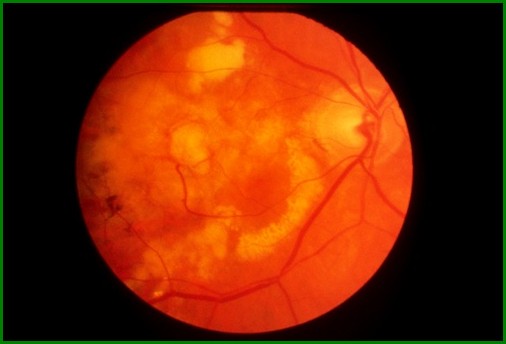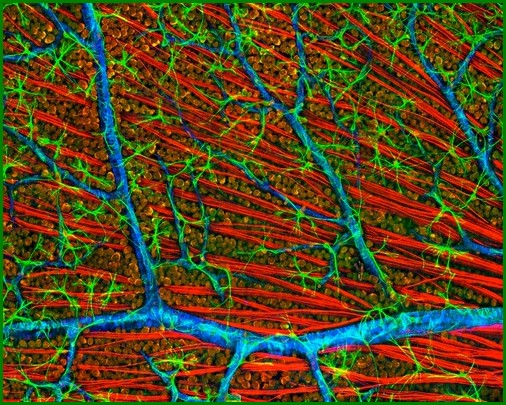Travelling to orbit bad for the state of the retina and optic nerve If traveling into orbit bad for the state of the retina and optic nerve, what will happen to the more distant travel, we have to assume only.

Retinal degeneration; visible region have lost a layer of pigmented cells that normally support the work of photoreceptor layer. (Photo by Lester V. Bergman.)
Ever since man was launched into space, the world never cease to excite global threats and hopes associated with extraterrestrial space. Aliens! Meteorites! The fading of the sun!
Loneliness in the universe! And so on ... We constantly develop plans in case of a meeting with an alien civilization, and discuss the space-time kunshtyukov in that can get Gagarin in space faced with the unknown physics of them.
Over time, however, it became clear that one of the most unpleasant kosmosyurprizov associated not so much with the extraterrestrial physics and newcomers as well with terrestrial biology. For the time being no one just did not think about the fact that people adapted to life on Earth, and the space - not our environment. So there is not ours, that it can stay pretty upset the body works at the molecular genetic level.
For example, we already know that the scouts deep space, most likely, in addition to other pleasures, will face blindness. A banal stay in weightlessness impairs vision. And if you come back to the heroes who rush on our orbit, it is worth to take care of the fact that they have the perfect set of genes ...
In general, yes, space is terrible for health advance, and what stays, to put it mildly, is accompanied by some problems with physiology, has never been a secret for professionals, just with the time scale of the problem became clear: they are now diagnosed in a variety of systems of the body.
About troubles with eyes in astronauts first began in 2001 (hello, Kubrick!). And this is a very serious conversations and diagnoses, up tomacular degeneration (Macular degeneration), which can lead to blindness (in the world it is, we recall, is developing into quite a late age). In 2011, NASA initiated a detailed eye examination in the seven astronauts who have spent in orbit for at least six months.
The result revealed that the space heroes misshapen eyeball and there is an anomaly in the choroid membrane, which lies behind the retina and is feeding blood vessels. These anomalies and strain apparently caused swelling of the optic nerve.
Of course, the first thing that comes to my mind - is the solar radiation: Is it she is the cause of molecular, cellular and physiological problems? The second thing that can affect our biology - the lack of gravity. Assess the impact of these factors on the eyes of the scientists tried Lyndon Johnson Space Center at NASA and The Methodist Hospital of Houston (USA): they ran the mice in the 13-day journey on the space shuttle Discovery and then compared the activity of genes in the retina of the animals on the first, fifth and the seventh day after the flight.
At the same time, Patricia Sheva-Barios (Patricia Chevez-Barrios) held several laboratory mice in conditions close to the space, and some animals were in regular terrestrial setting.
The ship is not able to provide equally good protection against cosmic radiation, like the earth's atmosphere, and because of this the cells caught in an unfamiliar environment, increases the level of oxygen radicals that damage biomolecules and intracellular organelles. And it makes the work more actively genes resisting oxidative stress. This is what is seen in mice, researchers have returned from space: in the retina of animal genes have fought hard to oxidative stress.
However, after a week of antioxidant genes calmed down.

Retina mouse under the microscope: the red thread - the fibers of the optic nerve, the blue pipes - the blood vessels, Green stars - glial cells. (Photo Visuals Unlimited / Corbis.)
Of course, these mice were in orbit a little longer, and perhaps they flocked there for half a year or longer, in the eyes of the pathology caused by oxidative stress, would have been much stronger. However, scientists were able to see and changes that remained in the animals and a week stay on Earth.
In the optic nerve in rodents, according to the authors, there was too much of the protein beta-amyloid. Its appearance accompanies nerve damage, in addition, excess beta-amyloid protein deposits in the form of Alzheimer's disease. Well, in addition to beta-amyloid in the optic nerve, a large number of glial cells, which again can be seen as a response to some damage.